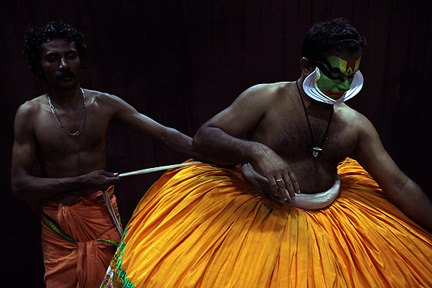
I’ve just returned from Kerala, India where I’ve been leading a 2 weeks photo-expedition, and I’m already suffering from acute withdrawal symptoms. No matter how many times I travel to photograph in South and South-East Asia, I still feel such symptoms when I return home, and I realize that the intensity of my photography, whether during festivals and rituals or just plain-vanilla street photography, is drug-like.
My just completed photo-expedition was both visually challenging and rewarding because of its diverse cultural and religious components. Some were carefully planned whilst others were serendipitous, but all offered the unique personality of Kerala on India’s Malabar Coast.
One of the cultural highlights of the expedition was a day-long session at a Kathakali school, where performers spent the better part of 4 hours applying their make-up for an hour-long dance.
Kathakali is a classic South Indian dance-drama which literally means “story-dance”. It originated in the16th century, approximately between 1555 and 1605, in Kerala and is based on earlier religious dances such as Koodiyattom, and others. It is fundamentally based on the Indian epic Ramayana, an ancient Sanskrit epic, considered one of the most important literary works on ancient India, and that has had a profound impact on art and culture in the Indian subcontinent and Southeast Asia.
The above photograph is of one of the 6 performers available that day, and while it was broad daylight when I was photographing, I decided to spot-meter the white parts of the performer’s make-up, which is painstakingly and meticulously applied by assistants, and throw the background into darkness. Looking back at the results of my Kathakali photo-shoot, I found that the pre-performance activities were infinitely more visually appealing than the performance itself. The facial and eye movements of the performers during the performance are key to its success, since each muscle twitch and eye movement signify a specific emotion, but these are fleeting and difficult to capture in a meaningful way. The make-up sessions hold considerable significance, and facial paint is applied with pre-ordained hand movements. Most of the makeup is made of natural substances, based on ancient recipes and formulas.
Sugato Mukherjee
30 Apr 2010Hi,
Congrats for sharing a very good image of kathakali. U have managed the exposure extremely well and the moment is dramatic. I shot the make up session once in Kochi and is looking forward to have a return visit. Where is this school where you shot this photograph?